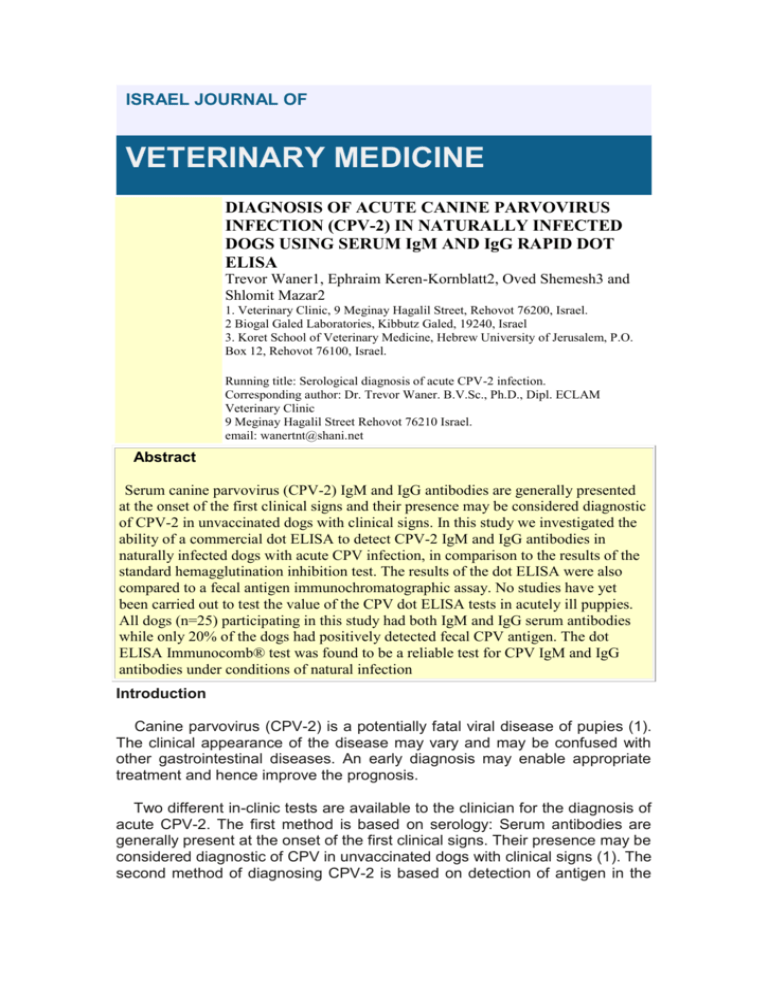DIAGNOSIS OF ACUTE CANINE PARVOVIRUS INFECTION (CPV-2)
advertisement

ISRAEL JOURNAL OF VETERINARY MEDICINE DIAGNOSIS OF ACUTE CANINE PARVOVIRUS INFECTION (CPV-2) IN NATURALLY INFECTED DOGS USING SERUM IgM AND IgG RAPID DOT ELISA Trevor Waner1, Ephraim Keren-Kornblatt2, Oved Shemesh3 and Shlomit Mazar2 Vol. 59 (1-2) 2004 1. Veterinary Clinic, 9 Meginay Hagalil Street, Rehovot 76200, Israel. 2 Biogal Galed Laboratories, Kibbutz Galed, 19240, Israel 3. Koret School of Veterinary Medicine, Hebrew University of Jerusalem, P.O. Box 12, Rehovot 76100, Israel. Running title: Serological diagnosis of acute CPV-2 infection. Corresponding author: Dr. Trevor Waner. B.V.Sc., Ph.D., Dipl. ECLAM Veterinary Clinic 9 Meginay Hagalil Street Rehovot 76210 Israel. email: wanertnt@shani.net Abstract Serum canine parvovirus (CPV-2) IgM and IgG antibodies are generally presented at the onset of the first clinical signs and their presence may be considered diagnostic of CPV-2 in unvaccinated dogs with clinical signs. In this study we investigated the ability of a commercial dot ELISA to detect CPV-2 IgM and IgG antibodies in naturally infected dogs with acute CPV infection, in comparison to the results of the standard hemagglutination inhibition test. The results of the dot ELISA were also compared to a fecal antigen immunochromatographic assay. No studies have yet been carried out to test the value of the CPV dot ELISA tests in acutely ill puppies. All dogs (n=25) participating in this study had both IgM and IgG serum antibodies while only 20% of the dogs had positively detected fecal CPV antigen. The dot ELISA Immunocomb® test was found to be a reliable test for CPV IgM and IgG antibodies under conditions of natural infection Introduction Canine parvovirus (CPV-2) is a potentially fatal viral disease of pupies (1). The clinical appearance of the disease may vary and may be confused with other gastrointestinal diseases. An early diagnosis may enable appropriate treatment and hence improve the prognosis. Two different in-clinic tests are available to the clinician for the diagnosis of acute CPV-2. The first method is based on serology: Serum antibodies are generally present at the onset of the first clinical signs. Their presence may be considered diagnostic of CPV in unvaccinated dogs with clinical signs (1). The second method of diagnosing CPV-2 is based on detection of antigen in the feces of dogs. Positive results are considered unequivocal evidence of an ongoing infection (2). The detection of serum antibodies to CPV-2 is usually carried out in diagnostic laboratories by the hemaggutination inhibition (HAI) test, or the immunofluoresence antibody (IFA) test (3). Both these assays require sophisticated equipment, trained personnel, and take a significant amount of time to run and interpret. Rapid dot ELISA methods are the favored method for the assay of CPV-2 antibodies in the clinic. Dot ELISA tests for IgG and IgM CPV antibodies have been validated (1, 2). The dot ELISA assay for IgG has been suggested for assessing the immunization status in puppies following vaccination (1). It has also been proposed that an IgM kit may serve to detect early clinical cases of CPV by using only a single serum sample test (2, 3). No studies have yet been carried out to test the value of the CPV dot ELISA tests in acutely ill puppies. In this study we investigated the ability of a commercial dot ELISA to detect CPV-2, IgM and IgG antibodies in naturally infected dogs with acute CPV infection, comparing the results with a fecal antigen immunochromatographic test. Materials and Methods Dogs: Twenty-five dogs of both mixed (24%) and pure breed (76%) were included in this study. Their average age was 4 months (minimum 1.5 months; maximum 14 months). The majority of dogs were about 2.5 months. Sixteen dogs were males and 9 were females. (Table 1). The dogs used in this study were cases submitted to the Veterinary Teaching Hospital of the University of Jerusalem. Criteria for the selection of cases eligible for inclusion in this study were based on unvaccinated dogs affected with a leukopenia of 5,500 leukocytes/µl, and a positive HAI Feces were collected from dogs at presentation at the Veterinary Teaching Hospital. The feces were immediately tested for CPV antigen. The dogs were treated using standard protocols consisting of supportive and antimicrobial therapy. Table 1: Signalment, major clinical signs and leukocyte count at presentation of dogs suspected of being naturally infected with canine parvovirus (CPV). Dog Breed Age (mo) Gender Temp. (0C) Vomiting Diarrhea WBC x103/µl 1 Mixed breed 3 M 39.1 + +B 2.6 2 Mixed breed 6 F 41.5 + +B 1.0 3 Mixed breed 3 M 38.5 + - 4.6 4 Am Staf Bull Terrier 3 M 38.5 + +B 1.6 5 Stafordshire bull terrier 2.5 M 38.9 + - 3.8 6 Stafordshire bull terrier 6 M 40.2 + + 3.7 7 Mastino M 38.3 + + 3.9 2 8 Stafordshire bull terrier 3 M 39.7 - + 5.3 9 Stafordshire bull terrier 3 F 39.4 + + 1.4 10 Dalmatian 3 M 38.7 + +B 4.3 11 Marimano 6 M 41.5 - - 1.4 12 Mixed breed 2 M 40.2 - - 1.4 13 Chihauhua 7 F 38.3 - - 0.3 14 Kavasz 2 F 39.4 + + 1.9 15 Mixed breed 4.5 M 38.6 + + 4.5 16 French Bulldog 2 M 38.6 + + 1.9 17 Miniature Pinscher 10 F 38.5 + +B 1.6 18 Dalmatian 2 F 37.8 - +B 4.8 19 Rottweiler 3 M ND ND ND 1.9 20 Mixed breed 14 M 40.4 + +B ND 21 Rottweiler 3 F 38.8 + + 3.8 22 Great Dane 1.5 F 38.9 + + 4.3 23 GSD 2 M 38.3 + + 1.6 24 Labrador 3 M 38.1 - + 0.6 25 Pekingese 2 F 38.5 + + 1.2 ND= not documented; B=bloody Am Staf Bull Terrier = American Stafordshire bull terrier GSD = German shepherd dog HAI assay: CPV-2 antibody titers were carried out on coded samples by the Cornell Diagnostic Laboratory (Ithaca, USA) using the HAI test as previously described (3). Serum dilutions were examined for the presence or absence of viral induced hemagglutination. The total antibody level was measured and expressed as the total IgG and IgM titers. Titers were expressed as the reciprocal of the serum dilutions that inhibit 4-8 hemagglutination units. Immunoassasy for the detection of parvovirus in feces: Detection of CPV antigen in feces was carried out using a qualitative monoclonal immunochromatographic assay (FASTest PARVO Strip, MegaCor, Horbranz, Austria). A single test was carried on each dog on admission. The test was carried out according to the instructions provided by the manufacturer. In brief, feces were collected shortly after admission. A small quantity of feces was diluted with the diluent provided. The diluted material was placed on the test pad and after 1 minute the results were read. A positive result was indicated by a clearly distinguishable pink/purple band in the test and control zones. Dot ELISA IgG and IgM immunoassays: Serum antibody titers to CPV IgM and IgG were determined on coded serum samples using a commercially available dot ELISA kit (Immunocomb, Biogal Laboratories, Kibbutz Gal’ed, Israel). The test was carried out as previously described (7). The concentration of CPV antibodies for each sample was measured, using a color coded scale provided in the kit and the results were expressed in "S units" on a scale of 0 to 6. Results The mean rectal temperature of the dogs was 39.10C (Minimum 37.80C; maximum 41.50C). Eighteen dogs (75%) presented with vomiting, and 19 dogs presented with diarrhea (79%), and 7 dogs (29%) exhibited bloody diarrhea. The mean total leukocyte count for the 25 dogs in the study was 2,640 leukocytes/µl. The minimum leukocyte count was 300 leukocytes /?l and the maximum was 5,300 leukocytes /µl. All dogs had CPV IgM titers at presentation as measured by the dot ELISA Immunocomb®. Twenty eight percent had IgM values of S=6; 60% of dogs had “S” values of 5; 8% dogs had “S” values of 4, and 4% of dogs had IgM “S” values of 3 (Table 2). Furthermore, all dogs in this study had CPV IgG antibodies as measured by the dot ELISA Immunocomb®. Their “S” values varied from 2 to 6. The distribution of the “S” values for IgG were 60% S=6; 28% S=5; and 4% had IgG “S” values of 4, 3, and 2 respectively (Table 2). On submission, only 5/25 dogs (20%) tested positive for CPV fecal antigen with the FASTest PARVO Strip (Table 2). Dog HAI Immunocomb®IgM (S units) Immunocomb®IgG(Sunits) Fecal antigen 1 1:2560 6 6 N 2 1:2560 5 6 N 3 1:2560 5 6 N 4 1:160 6 6 N 5 1:2560 5 6 N 6 1:1280 5 6 N 7 1:1280 6 6 N 8 1:640 5 6 N 9 1:320 6 6 N 10 1:160 4 2 N 11 1:1280 5 6 N 12 1:5210 5 5 N 13 1:640 5 5 N 14 1:1280 5 5 N 15 1:5120 6 6 N 16 1:320 6 6 P 17 1:320 6 6 N 18 1:160 4 3 N 19 1:2560 5 6 P 20 1:2560 5 5 P 21 1:640 5 4 N 22 NR 5 6 N 23 1:640 5 5 N 24 1:320 5 5 P 25 1:160 3 5 P Discussion In our study, acutely ill animals demonstrated CPV-IgG antibodies early at the first appearance of clinical and clinical-pathological signs such as fever, vomiting, diarrhea, and leukopenia. In unvaccinated pupies this is considered to be a reliable indicator of disease due to CPV-2 (4). Furthermore, CPV-IgM antibodies were also demonstrated. The presence of IgM antibodies adds weight to a very recent exposure to CPV-2 and strengthen the diagnosis of acute CPV-2 infection (2, 3, 5). In a previous study, data was presented for assessing the response to vaccination for CPV-2 by measuring CPV IgG antibodies using a commercially available rapid in-clinic dot ELISA kit (4). The validity of the kit was verified by comparing its results with the standard HAI test. The use of the kit was suggested for assessment of immunization status of pupies postvaccination, in order to overcome the problem of interference caused by maternal antibodies, since this interference is considered a major cause of CPV-2 vaccination failure (6, 7). In a follow-up study, a CPV IgM dot ELISA kit was developed for use in the diagnosis of acutely ill dogs with CPV by using a single serum sample test (3). In the present study we have assessed the diagnostic value of using the dot ELISA Immunocomb® for the rapid in-clinic detection of both IgM and IgG CPV-2 antibodies in acutely ill dogs, compared to the fecal antigen kit. All dogs in this study had serum IgM and IgG antibodies. The results are in accordance with a recent study in which we followed the kinetics of CPV serum IgM and IgG after vaccination (3). However, compared to the CPV post-vaccination kinetic experiment, the titers of IgM antibodies in the naturally infected dogs were quantitatively higher, with 28% of dogs showing the maximum S=6 titer in the natural infection data, while no dogs with the equivalent titers were found in the vaccination experiment. This quantitative difference may be attributable to the virulence and or immunogencity of the virus in the case of the natural infection. While all dogs participating in this study had both IgM and IgG serum antibodies only 20% of the dogs had positively detected fecal CPV antigen. The reason for the relatively low success of the fecal antigen kit is not clear, but may be related to antibodies in the intestinal tract which bind to parvovirus virions and thus inhibit their detection by the immunochromatographic assay (5). In conclusion, we found that the dot ELISA Immunocomb® was a reliable test for CPV IgM and IgG under conditions of natural infection. The importance of early diagnosis and treatment of CPV infected dogs, justifies the use of an in-clinic, accurate, objective and rapid test for CPV. LINKS TO OTHER ARTICLES IN THIS ISSUE References 1. Appel MJ, 1969: Pathogenesis of canine distemper. Am J Vet Res 30:11671181. 2. Florent G: 1986, Enzyme-linked immunosorbent assay for single serum diagnosis of canine parvovirus disease. Vet Rec 119:479-480. 3. Waner T, Mazar S, Nachmias E, Korn-Kornblatt E, Harrus S: 2002, Evaluation of a dot ELISA kit for canine parvovirus and canine distemper virus immunoglobin M (IgM) antibodies. Vet Rec 152:588-591, 2003. 4. Carmichael LE, Joubert JC, Pollock RVH: 1980, Hemagglutination by canine parvovirus: serologic studies and diagnostic applications. Am J Vet Res 41:784-791. 5. Hoskin JD: 2000, Canine viral diseases. In: Textbook of Veterinary Internal Medicine, Ettinger SJ, Feldman EC, eds. pp. 420-422. W.B. Saunders, Co., Philadelphia 6. Carmichael LE, Olin JM: 1983, Immunization strategies in puppies - why failures? Compend Cont Educ Pract Vet 5:1043-1051. 7. Waner T, Naveh A, Wudovsky I, Carmichael LE: 1996, Assessment of maternal antibody decay and response to canine parvovirus vaccination using a clinic-based enzyme-linked immunosorbent assay. J Vet Diagn Invest 8:427-432. 1.




